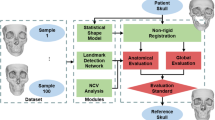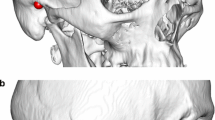Abstract
Objectives
The aim of this study was to propose and validate an automatic approach based on iterative closest point algorithm for virtual complement and reconstruction for maxillofacial bone defects.
Materials and methods
A 3D craniomaxillofacial database of normal Chinese people including 500 skull models was established. Modified iterative closest point (ICP) algorithm was developed to complete bone defects automatically. The performances were evaluated by two approaches: (1) model experiment, virtual bony defects were created on 30 intact normal skull models not included in the database. For each defect model, the algorithm was applied to select the reference skull model from the database. 3-Dimensional and 2-dimensional comparison were conducted to evaluate the error between reference skull model with original intact model. Root mean square error (RMSE) and processing time were calculated. (2) Clinical application, the algorithm was utilized to assist reconstruction of 5 patients with maxillofacial bone defects. The symmetry of post-operative skull model was evaluated by comparing with its mirrored model.
Results
The algorithm was tested on an CPU with 1.80 GHz and average processing time was 493.5 s. (1) Model experiment, the average root-mean-square deviation of defect area was less than 2 mm. (2) Clinical application, the RMSE of post-operative skull and its mirrored model was 1.72 mm.
Conclusion
It is feasible using iterative closest point algorithm based on normal people database to automatically predict the reference data of missing maxillofacial bone.
Clinical relevance
An automated approach based on ICP algorithm and normal people database for maxillofacial bone defect reconstruction has been proposed and validated.








Similar content being viewed by others
Change history
27 November 2021
A Correction to this paper has been published: https://doi.org/10.1007/s00784-021-04246-3
References
Brown J, Shaw R (2010) Reconstruction of the maxilla and midface: introducing a new classification. Lancet Oncol 11:1001
Brown JS, Barry C, Ho M, Shaw R (2016) A new classification for mandibular defects after oncological resection. Lancet Oncol 17:e23. https://doi.org/10.1016/s1470-2045(15)00310-1
Genden EM (2010) Reconstruction of the mandible and the maxilla: the evolution of surgical technique. Arch Facial Plast Surg 12:87. https://doi.org/10.1001/archfacial.2010.18
Hirsch DL, Garfein ES, Christensen AM, Weimer KA, Saddeh PB, Levine JP (2009) Use of computer-aided design and computer-aided manufacturing to produce orthognathically ideal surgical outcomes: a paradigm shift in head and neck reconstruction. J Oral Maxillofac Surg 67:2115. https://doi.org/10.1016/j.joms.2009.02.007
van Baar GJC, Forouzanfar T, Liberton N, Winters HAH, Leusink FKJ (2018) Accuracy of computer-assisted surgery in mandibular reconstruction: a systematic review. Oral Oncol 84:52. https://doi.org/10.1016/j.oraloncology.2018.07.004
Tepper OM, Sorice S, Hershman GN, Saadeh P, Levine JP, Hirsch D (2017) Use of virtual 3-dimensional surgery in post-traumatic craniomaxillofacial reconstruction. J Oral Maxillofac Surg 69:733. https://doi.org/10.1016/j.joms.2010.11.028
Zhang Y, He Y, Zhang ZY, An JG (2010) Evaluation of the application of computer-aided shape-adapted fabricated titanium mesh for mirroring-reconstructing orbital walls in cases of late post-traumatic enophthalmos. J Oral Maxillofac Surg 68:2070. https://doi.org/10.1016/j.joms.2009.08.029
Pierrefeu A, Terzic A, Volz A, Courvoisier D, Scolozzi P (2015) How accurate is the treatment of midfacial fractures by a specific navigation system integrating “mirroring” computational planning? Beyond mere average difference analysis. J Oral Maxillof Surg 73:315.e1. https://doi.org/10.1016/j.joms.2014.09.022
Gui H, Yang H, Zhang S, Shen SGF, Ye M, Schmelzeisen R (2015) Mirroring tool: the simplest computer-aided simulation technology? J Craniofac Surg 26:2115. https://doi.org/10.1097/scs.0000000000000913
Gibelli D, Cellina M, Gibelli S, Oliva AG, Termine G, Pucciarelli V, Dolci C, Sforza C (2018) Assessing symmetry of zygomatic bone through three-dimensional segmentation on computed tomography scan and “mirroring” procedure: a contribution for reconstructive maxillofacial surgery. J Craniomaxillofac Surg 46:600. https://doi.org/10.1016/j.jcms.2018.02.012
Yao B, He Y, Jie B, Wang J, An J, Guo C, Zhang Y (2019) Reconstruction of bilateral post-traumatic midfacial defects assisted by three-dimensional craniomaxillofacial data in normal Chinese people-a preliminary study. J Oral Maxillofac Surg 77:2302 e1. https://doi.org/10.1016/j.joms.2019.04.030
Salhi A, Burdin V, Boutillon A, Brochard S, Mutsvangwa T, Borotikar B (2020) Statistical shape modeling approach to predict missing scapular bone. Ann Biomed Eng 48:367. https://doi.org/10.1007/s10439-019-02354-6
Plessers K, VandenBerghe P, Van Dijck C, Wirix-Speetjens R, Debeer P, Jonkers I, Vander Sloten J (2018) Virtual reconstruction of glenoid bone defects using a statistical shape model. J Shoulder Elbow Surg 27:160. https://doi.org/10.1016/j.jse.2017.07.026
Horn BKP (1986) Closed-form solution of absolute orientation using uni t quaternions.
**ong Y, Zhao Y, Yang H, Sun Y, Wang Y (2016) Comparison Between interactive closest point and procrustes analysis for determining the median sagittal plane of three-dimensional facial data. J Craniofac Surg 27:441. https://doi.org/10.1097/scs.0000000000002376
Hanasono MM, Jacob RF, Bidaut L, Robb GL, Skoracki RJ (2010) Midfacial reconstruction using virtual planning, rapid prototype modeling, and stereotactic navigation. Plast Reconstr Surg 126:2002. https://doi.org/10.1097/PRS.0b013e3181f447e1
Foley BD, Thayer WP, Honeybrook A, McKenna S, Press S (2013) Mandibular reconstruction using computer-aided design and computer-aided manufacturing: an analysis of surgical results. J Oral Maxillofac Surg 71:e111. https://doi.org/10.1016/j.joms.2012.08.022
Jie B, Yao B, Li R, An J, Zhang Y, He Y (2020) Post-traumatic maxillofacial reconstruction with vascularized flaps and digital techniques: 10-year experience. Int J Oral Maxillofac Surg 49:1408. https://doi.org/10.1016/j.ijom.2020.04.012
Zhang WB, Yu Y, Wang Y, Mao C, Liu XJ, Guo CB, Yu GY, Peng X (2016) Improving the accuracy of mandibular reconstruction with vascularized iliac crest flap: role of computer-assisted techniques. J Craniomaxillofac Surg 44:1819. https://doi.org/10.1016/j.jcms.2016.08.014
Gellrich NC, Schramm A, Hammer B, Rojas S, Cufi D, Lagreze W, Schmelzeisen R (2002) Computer-assisted secondary reconstruction of unilateral posttraumatic orbital deformity. Plast Reconstr Surg 110:1417. https://doi.org/10.1097/01.PRS.0000029807.35391.E5
Lübbers HT, Jacobsen C, Matthews F, Grätz KW, Kruse A, Obwegeser JA (2011) Surgical navigation in craniomaxillofacial surgery: expensive toy or useful tool? A classification of different indications. J Oral Maxillofac Surg 69:300
Maintz JBA, Viergever MA (1998) A survey of medical image registration. Med Image Anal 2:1. https://doi.org/10.1016/S1361-8415(01)80026-8
Fuessinger MA, Schwarz S, Cornelius CP, Metzger MC, Ellis E 3rd, Probst F, Semper-Hogg W, Gass M, Schlager S (2018) Planning of skull reconstruction based on a statistical shape model combined with geometric morphometrics. Int J Comput Assist Radiol Surg 13:519. https://doi.org/10.1007/s11548-017-1674-6
Qiu L, Zhou Z, Guo J, Lv J (2016) An automatic registration algorithm for 3D maxillofacial model. 3D Res 7:20. https://doi.org/10.1007/s13319-016-0083-x
Zhang WB, Wang Y, Liu XJ, Mao C, Guo CB, Yu GY, Peng X (2015) Reconstruction of maxillary defects with free fibula flap assisted by computer techniques. J Craniomaxillofac Surg 43:630. https://doi.org/10.1016/j.jcms.2015.03.007
Liu XJ, Gui L, Mao C, Peng X, Yu GY (2009) Applying computer techniques in maxillofacial reconstruction using a fibula flap: a messenger and an evaluation method. J Craniofac Surg 20:372. https://doi.org/10.1097/SCS.0b013e31819b9443
Gong X, He Y, He Y, An JG, Yang Y, Zhang Y (2014) Quantitation of zygomatic complex symmetry using 3-dimensional computed tomography. J Oral Maxillofac Surg 72:2053 e1. https://doi.org/10.1016/j.joms.2014.06.447
Yamamoto H, Morikawa K, Yamashina EU (2001) An anatomical study of the medial canthus using a three-dimensional model. Aesthetic Plast Surg 25(3):189
Acknowledgements
The authors acknowledge Dr. Kaiyuan Fu, Dr. Chengyi Wang, and Dr. Yanhang Tong (Peking University School and Hospital of Stomatology) for develo** the normal people database.
Funding
This study was supported by National Key Research and Development Program of China (grant No. 2019YFF0302401&2017YFB1104103), National Natural Science Foundation of China (grant No. (82027807&81771940) and Bei**g Municipal Natural Science Foundation (7212202).
Author information
Authors and Affiliations
Corresponding authors
Ethics declarations
Ethics approval
All procedures performed in studies involving human participants were in accordance with the ethical standards of the institutional and/or national research committee and with the 1964 Helsinki declaration and its later amendments or comparable ethical standards. The ethics committee of Peking University School and Hospital of Stomatology (PKUSSIRB-201837100) approved this study.
Consent to participate
Informed consent was obtained from all individual participants included in the study.
Conflict of interest
The authors declare no competing interests.
Additional information
Publisher's note
Springer Nature remains neutral with regard to jurisdictional claims in published maps and institutional affiliations.
The original version of this article was revised: This article was originally published with figures not in its appropriate figure captions.
Supplementary Information
Below is the link to the electronic supplementary material.
Rights and permissions
About this article
Cite this article
Jie, B., Han, B., Yao, B. et al. Automatic virtual reconstruction of maxillofacial bone defects assisted by ICP (iterative closest point) algorithm and normal people database. Clin Oral Invest 26, 2005–2014 (2022). https://doi.org/10.1007/s00784-021-04181-3
Received:
Accepted:
Published:
Issue Date:
DOI: https://doi.org/10.1007/s00784-021-04181-3




